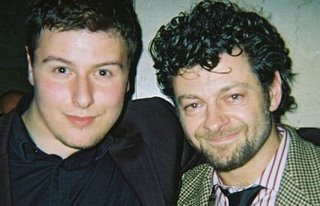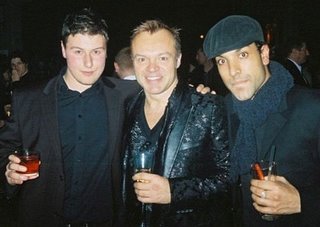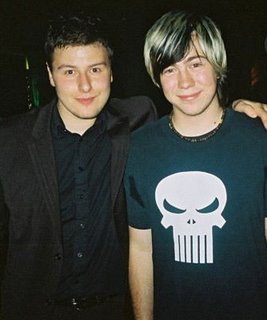DM MEETS ANDY SERKIS

King Kong (PG13)
reviewed by David Mahmoudieh at the UK premier
“RETURN OF THE KING”
It’s been seventy-two long years since the Empire State Building lost its giant primate accessory. And given today’s current climates, I doubt Kong would even get as far as Times Square, let alone airborne, before Uncle Sam’s on-standby cavalry cut through the skies and shipped him off to Guantanimo.
Nevertheless, just as if he’s just stepped right out a Delorean, the giant beast is back, this time at the wand of cinematic wizard Peter Jackson (director of the Lord of the Rings Trilogy) who takes on the filmmaking equivalent of Kong himself.
Having tried to make the film over a decade ago, Jackson, who by his own admission considers project Kong ‘his precious’ above all others, claims his fixation with the original 30’s classic was the inspirational milestone that propelled him into filmmaking when he first saw it, aged 9. His infatuation to re-make his childhood highlight has haunted him ever since, right up until 34 years later when he’s finally fulfilled a life-long dream in unleashing the beast back from the wilderness. Albeit with $207m at his disposal and a CGI makeover.
But credit to Jackson, for this is no shot-for-shot carbon remake. The multi-Oscar-winning director has completely re-invented Kong and the expansive backdrops of the first film.
Though an avid fan of the original, Jackson wasn’t afraid to fabricate the story -- evident right from the off in the way he’s added his own identity into the characters. In the original, Kong’s pioneers are merely a team of adventurers, seeking out a showpiece on an uncharted isle. This time round though, protagonist Carl Denham (Jack Black) is a Jackson-like maverick filmmaker himself, who, having discovered a map to an ancient unfound province hidden somewhere far in the nucleus of the sea -- rather appropriately named ‘Skull Island’-- sets out to find this un-chartered utopian territory where a ready-made celestial location awaits.
Accompanying Denham on his directorial dream are writer Jack Driscoll (Adrien Brodie) and the role made famous by the late, great Faye Dunnaway, Ann Darrow, a down-on-her-luck actress and reluctant heroine of Driscoll’s project, portrayed worthily enough by Naomi Watts.
No sooner have the stardom-seekers enigmatically arrived, somewhat Christopher Columbus-style like a vessel into the unknown -- than the island tribes-people have welcomed the gang in their accustomed fashion -- abducting Ann for a ritual sacrifice to their leader and guardian; a gigantic ape they call ‘Kong’.
Chivalrous and bold -- as they were back then, you know -- the ship’s crew set out to find her, unbeknown of the other carnivorous inhabitants that lurk amongst the forestry.
They needn’t have bothered with the hassle, as the imposing 24-ft Kong has no intention of devouring Denham’s lead actress -- the hole in his heart far greater than the one in his stomach. Through the shaggy fur and ferocious exterior lies an aching compassion, as beast becomes protector, shielding Darrow from the many perils of his domain.
Now, come on, physically, it just wouldn’t work. But all love is blind and Kong is no different. Cue the lurid love triangle between Brody, Watts and… yes, a giant ape.
Subsequent to his brush with nature, the CGI team worked tirelessly, capturing precise detail of his facial expressions. And behind all that hair and rough, tough skin, you can sure see a little bit of the old Gollum.
With all the audacious elements of an evocative and meticulously nostalgic apparition of the colossal ape in place, the superb set and art direction, and a true-to-the-time musical score, Kong was ready to rumble. And what a rumble it is, too.
For a three-hour film, the pace moves incredibly fast. The script pokes fun at itself on a fairly constant basis, although never straying so far over the line that it morphs into self-parody. The final pay-off is a feast for the eyes, when the rampant beast swaps the native jungles of Skull Island for the urban Jungle of New York City, tearing up the concrete terrain and throwing cars across the street as if they had ‘Corgi’ written underneath them.
Finally, aside from the inevitable similarities we may strive to strike between Kong and the LOTR films, a mention should also go out to their dissimilarities too, in the way Jackson manages to sow his Middle-Earth oats and turn Kong into an oddity in its own right. The film broadcasts its memorandum a lot less allegorical than the at-times over-emblematic thesis found in the Rings Trilogy. And such subtleties weren’t stumbled upon by accident. Catching a moment with a somewhat slimmer Jackson en route to the men’s toilets, he was kind, and also somewhat tipsy enough to explain, “I don’t think Kong carries a message. I just wanted to entertain people.”
And he certainly does.
© David Mahmoudieh 2005

King Kong (PG13)
reviewed by David Mahmoudieh at the UK premier
“RETURN OF THE KING”
It’s been seventy-two long years since the Empire State Building lost its giant primate accessory. And given today’s current climates, I doubt Kong would even get as far as Times Square, let alone airborne, before Uncle Sam’s on-standby cavalry cut through the skies and shipped him off to Guantanimo.
Nevertheless, just as if he’s just stepped right out a Delorean, the giant beast is back, this time at the wand of cinematic wizard Peter Jackson (director of the Lord of the Rings Trilogy) who takes on the filmmaking equivalent of Kong himself.
Having tried to make the film over a decade ago, Jackson, who by his own admission considers project Kong ‘his precious’ above all others, claims his fixation with the original 30’s classic was the inspirational milestone that propelled him into filmmaking when he first saw it, aged 9. His infatuation to re-make his childhood highlight has haunted him ever since, right up until 34 years later when he’s finally fulfilled a life-long dream in unleashing the beast back from the wilderness. Albeit with $207m at his disposal and a CGI makeover.
But credit to Jackson, for this is no shot-for-shot carbon remake. The multi-Oscar-winning director has completely re-invented Kong and the expansive backdrops of the first film.
Though an avid fan of the original, Jackson wasn’t afraid to fabricate the story -- evident right from the off in the way he’s added his own identity into the characters. In the original, Kong’s pioneers are merely a team of adventurers, seeking out a showpiece on an uncharted isle. This time round though, protagonist Carl Denham (Jack Black) is a Jackson-like maverick filmmaker himself, who, having discovered a map to an ancient unfound province hidden somewhere far in the nucleus of the sea -- rather appropriately named ‘Skull Island’-- sets out to find this un-chartered utopian territory where a ready-made celestial location awaits.
(Amongst the attendees at the Freemason Hall afterparty in London
were, Graham Norton, actor and close friend Arun Shanti, and
former Busted band member James Bourne, below)
No sooner have the stardom-seekers enigmatically arrived, somewhat Christopher Columbus-style like a vessel into the unknown -- than the island tribes-people have welcomed the gang in their accustomed fashion -- abducting Ann for a ritual sacrifice to their leader and guardian; a gigantic ape they call ‘Kong’.
Chivalrous and bold -- as they were back then, you know -- the ship’s crew set out to find her, unbeknown of the other carnivorous inhabitants that lurk amongst the forestry.
They needn’t have bothered with the hassle, as the imposing 24-ft Kong has no intention of devouring Denham’s lead actress -- the hole in his heart far greater than the one in his stomach. Through the shaggy fur and ferocious exterior lies an aching compassion, as beast becomes protector, shielding Darrow from the many perils of his domain.
Now, come on, physically, it just wouldn’t work. But all love is blind and Kong is no different. Cue the lurid love triangle between Brody, Watts and… yes, a giant ape.
As wild and outlandish as it all sounds, Jackson somehow makes it work and delivers a stellar end product. His version encompasses an all-new realm of great spectacle, permeated with the adolescent marvel that is fast-becoming his hallmark. Again he casts his spell on us, his latter films having such a habit of infecting a universal audience. The Kiwi director seems to foster some kind of hybrid understanding of the human condition, once again, creating a genuine attrition and connection between his characters and the audience. None more so than Kong, who behind the masquerade of digital enhancement, is made up of none other than British actor Andy “Gollum” Serkis.
CONVERSATIONS WITH A MONKEY
Following his expert portrayal of a digital embodiment in the Rings Trilogy, Serkis (pictured) was entrusted with a huge responsibility of the title role. I was fortunate enough to get my moment with Serkis at the charity premiere in London, who took time and genuine thoroughness in explaining how he made King Kong more than just a CGI entity. “Kong was a much more physically challenging role than Gollum”, he said. “I had to completely lose that tag [of Gollum]. Every movement I made, I was conscious to make it completely independent of Smeagle.”
The preparation didn’t end there. For months he studied the movements of silverbacks on varying scales. He went on to explain, “I went to Rwanda, via a detour at London Zoo, analysing the contrasts between gorillas in captivity and those in the freedom of the jungles. It was always going to be important to study these creatures. With Gollum, he had the benefit of communicating through words. But for Kong, it was all about letting his demeanour do the talking.”
Whether the wild apes picked up a thing or two from Serkis is another matter. Though the actor does confess to now always lifting himself up by his knuckles from a sitting position.
The preparation didn’t end there. For months he studied the movements of silverbacks on varying scales. He went on to explain, “I went to Rwanda, via a detour at London Zoo, analysing the contrasts between gorillas in captivity and those in the freedom of the jungles. It was always going to be important to study these creatures. With Gollum, he had the benefit of communicating through words. But for Kong, it was all about letting his demeanour do the talking.”
Whether the wild apes picked up a thing or two from Serkis is another matter. Though the actor does confess to now always lifting himself up by his knuckles from a sitting position.
“It makes so much sense, try it sometime.”
Subsequent to his brush with nature, the CGI team worked tirelessly, capturing precise detail of his facial expressions. And behind all that hair and rough, tough skin, you can sure see a little bit of the old Gollum.
With all the audacious elements of an evocative and meticulously nostalgic apparition of the colossal ape in place, the superb set and art direction, and a true-to-the-time musical score, Kong was ready to rumble. And what a rumble it is, too.
For a three-hour film, the pace moves incredibly fast. The script pokes fun at itself on a fairly constant basis, although never straying so far over the line that it morphs into self-parody. The final pay-off is a feast for the eyes, when the rampant beast swaps the native jungles of Skull Island for the urban Jungle of New York City, tearing up the concrete terrain and throwing cars across the street as if they had ‘Corgi’ written underneath them.
Finally, aside from the inevitable similarities we may strive to strike between Kong and the LOTR films, a mention should also go out to their dissimilarities too, in the way Jackson manages to sow his Middle-Earth oats and turn Kong into an oddity in its own right. The film broadcasts its memorandum a lot less allegorical than the at-times over-emblematic thesis found in the Rings Trilogy. And such subtleties weren’t stumbled upon by accident. Catching a moment with a somewhat slimmer Jackson en route to the men’s toilets, he was kind, and also somewhat tipsy enough to explain, “I don’t think Kong carries a message. I just wanted to entertain people.”
And he certainly does.
© David Mahmoudieh 2005



